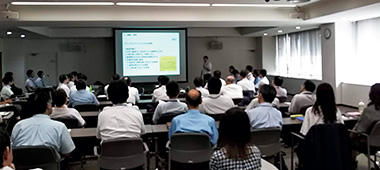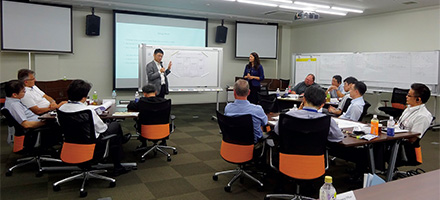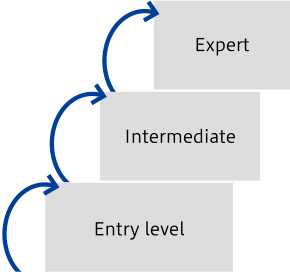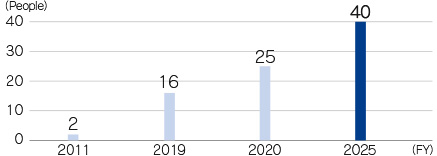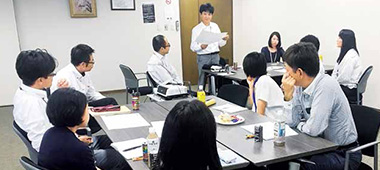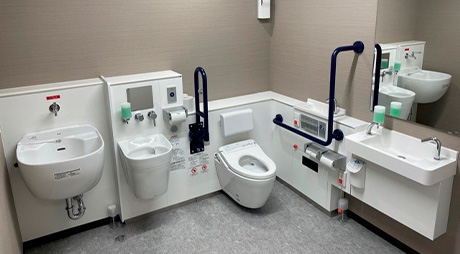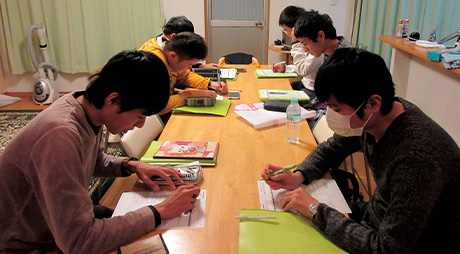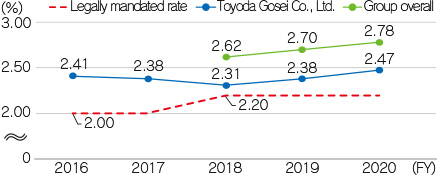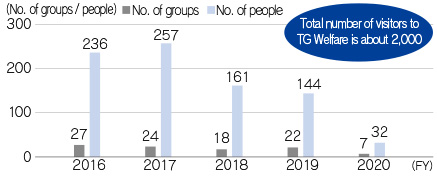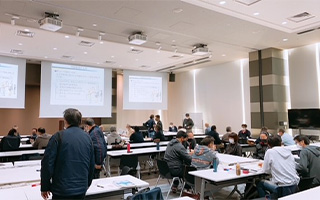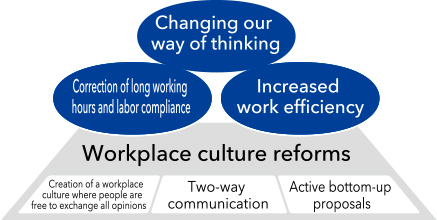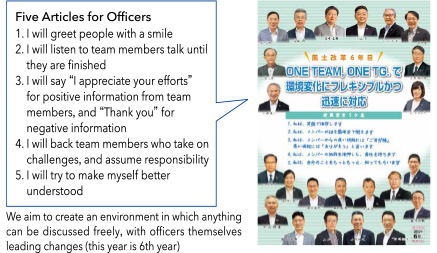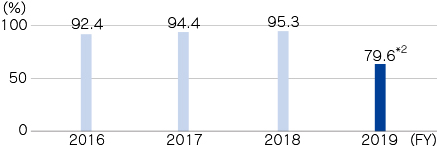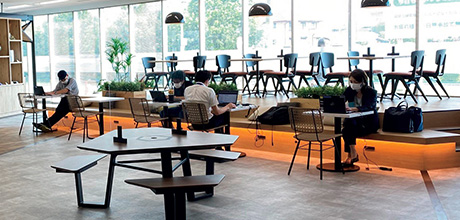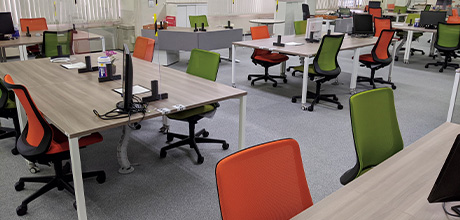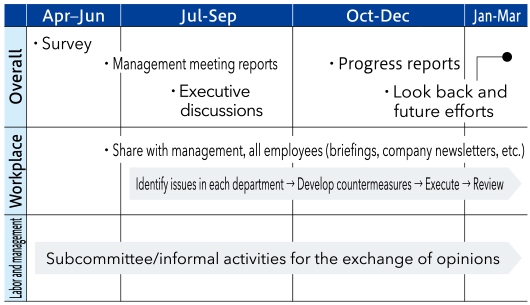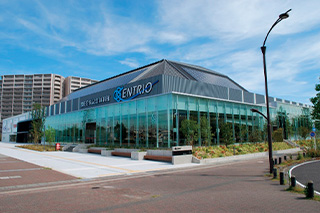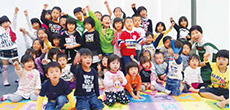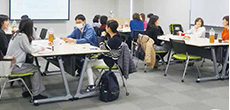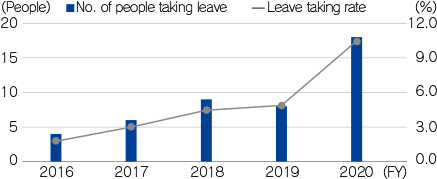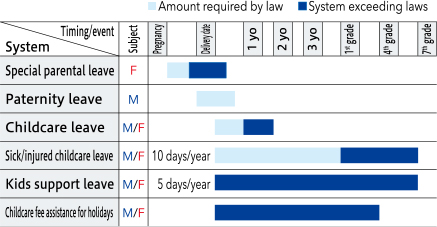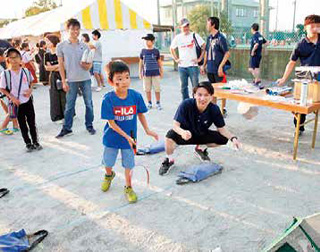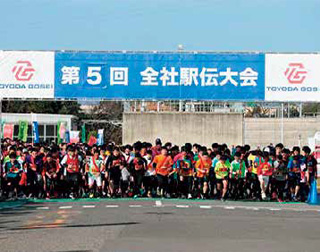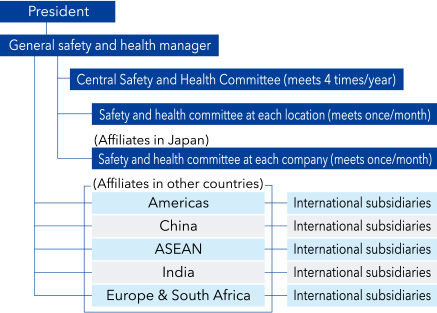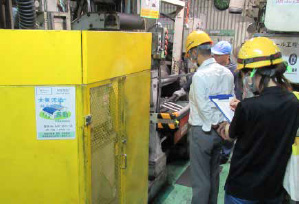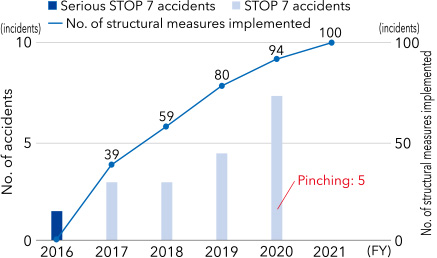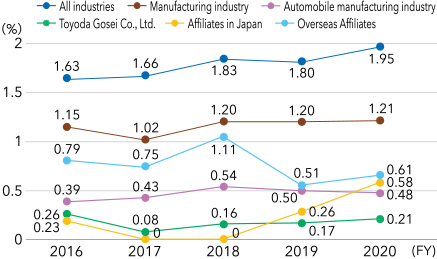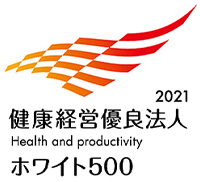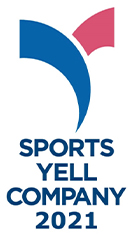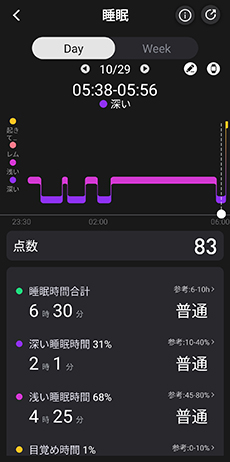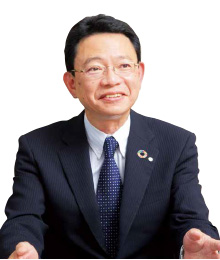
Employee Relations
1.Promote the development of human resources
(1) Development of candidates for global executive personnel
(2) “Management declaration activity” in which division and department general managers clearly show their organization’s vision
(3) “Constructive problem-solving training for the TG vision” that thinks backward from the company we want to be in the future
(4) “New employee 3-year independence plans” and “Overseas training assignments”
(5) “Digital personnel development” for people who can carry out DX
(6) Special Skills Dojos, Maintenance Skills Dojos, and Mold Skills Dojos raise the level of skill on the manufacturing floor
2.Active participation of a diverse workforce
(1) “Challenge program” to promote the development of female managers
(2) Active “mid-career hiring” and incoming training at the time of hiring
(3) Retirement age lifted to 65 to further promote the active participation of senior employees
(4) Employment rate of people with disabilities
3.Create a positive and pleasant corporate culture
(1) “Workstyle reforms” utilizing IT, such as promoting electronic approval and telework
(2) Clarification of organizational issues and execution of countermeasures with “engagement surveys”
(3) “Harassment prevention training” for managers and supervisors in the company
(4) Various measures to balance childcare, elder care, and work
(5) “Entrio” memorial gymnasium and sports club activities
(6) Health management
FY 2025 priority item targets
| Classification | Item | FY2021 results | FY2025 target |
|---|---|---|---|
|
1
Promotion of human resources development |
No. of people who have taken training for executive personnel | 54 | 65 |
| Percentage of people who have had overseas assignments (management, technical personnel) | 22.7% | 25% or higher | |
| No. of DX personnel trainers | 94 | 270 | |
|
2
Active participation of a diverse workforce |
No. of female managers | 30 | 40 |
| Percentage of management who are mid-career hires | 31.0% | 30% or higher | |
| Local executive percentage (VP and above of overseas affiliates) | 28.3% | 40% or higher | |
| Employment rate of people with disabilities | 2.78% (entire Group in Japan) |
Achievement of legally mandated rate (all Group companies in Japan) |
|
|
3
Creating pleasant workplace environments |
Average overtime hours | 12.3 h/month | Less than 10.0 h/month |
| Annual paid leave taking rate | 97.3% | 90% or higher | |
| Engagement survey results | 56% (positive evaluation) | 65% or higher |
Respect for human rights
Basic philosophy
The Toyoda Gosei Group respects the United Nations’ Universal Declaration of Human Rights, the UN Guiding Principles on Business and Human Rights, and other international norms. The Toyoda Gosei Group Charter for Business Ethics lays out our basic principles of “respecting human rights and the diversity, character, and individuality of each person and striving to create workplaces that are free of discrimination and harassment and always healthy, pleasant and safe, based on labor-management cooperation.” The Toyoda Gosei Guidelines for Business Ethics, our behavioral standards to realize the ideals in the Charter, declares respect for individual character, human rights, and fairness in hiring, and forbids forced labor and child labor.
■Toyoda Gosei Group Human Rights Policy
In order to accelerate existing efforts to Respect Human Rights activities, we have established “Toyoda Gosei Group Human Rights Policy” in April 2022. The policy was developed with a support from external experts, reviewed by all Officers and Chiefs of Divisions at the Sustainability Meeting and approved at the Board of Directors Meeting. Also, we have shared the “Sustainability Guideline for Suppliers” with our suppliers and asked for their cooperation.
■Reporting Structure
Respect for human rights activity is discussed at the Human Resources Meeting and reported at the Sustainability Meeting.
■Education on Respect for Human Rights
In the Toyoda Gosei Group, education on the company’s human rights policy is provided at various opportunities, including new employee orientation and at the time of promotions. Human resources personnel are also sent for outside training to learn about human rights issues professionally. These efforts are made to develop HR personnel with superior sensitivity to human rights.
■Harassment prevention
Together with training for executives, managers, supervisors and others, a “TG Positive Workplace Support Squad” report is sent out about once a month and all employees strive to create a healthy and pleasant workplace free of harassment.
■Efforts at domestic and international Group companies
Self-check surveys are conducted at 52 Group companies (as of April 2021) in Japan and other countries to understand the status of human resources management compliance and human rights in accordance with the laws of each country and the Toyoda Gosei Group Charter for Business Ethics. Issues uncovered in the surveys are addressed in coordination with relevant departments in the company and the regional headquarters, and mechanisms are put in place to handle human rights due diligence and spread activities for improvement.
Stable employment
The company and labor union, from the many difficulties experienced together in the chaotic years after World War 2, strive for long-term stable employment and to maintain and improve labor conditions. A labormanagement declaration was issued on the occasion of the company’s 50th anniversary, and frank exchanges of opinion have been carried out in various workplaces based on mutual trust and responsibility of labor and management. This is founded on the firm belief that company growth leads to the happiness of the people working there. Efforts are always being made to achieve this management philosophy.
Measures are also carried out based on the laws and regulations of each country and region and our global human resources management policy. We constantly strive to strengthen the human resources management foundation and maintain and improve healthy labormanagement relations.
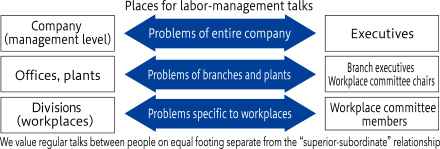
Promotion of human resources development
To raise the collective strength of Toyoda Gosei globally, we are striving to develop human resources and create workplace environments where each employee can display his or her full abilities.
Training of global executive candidates
For the systematic training of people who will manage the company in the future, we have introduced a program to help people learn how to look at and think about things at the management level and cultivate the qualities that will help them bear higher levels of work responsibility, with aims such as broadening their outlook and improving their judgment. Outside Japan, we are training executive candidates globally with the introduction of a certification system for solving problems by clarifying issues and setting goals.
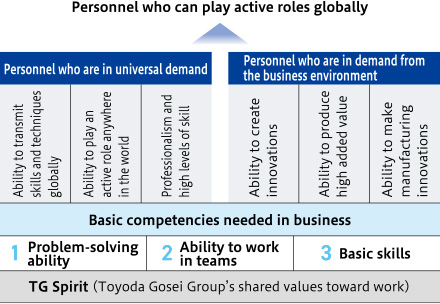
Improving ability to build visions
The ability to create a vision is important in organizational management. We are helping people to learn the importance of and how to create visions that can be used in management, starting with our Management Declaration Activity that clearly shows the organization’s vision for division and department general managers. We have also introduced training for newly appointed executives that involves higher order thinking in which they construct visions to solve problems. They also learn the importance of having a vision and how to create one, and try to implement it in their management.
New employee 3-year independence training program
For the early training of new employees, we have introduced a “New employee OJT system” for independence in three years. We provide both onthe- job training and classroom training to help them perform their work according to the PDCA cycle within a few years after joining the company. Interviews in the pivotal fourth and sixth years in the company are held to understand the situation of new employees, discover problems early, and take measures to counter them.

“Digital personnel development” for people who can carry out DX
In response to the rapidly changing business environment, we are overhauling production processes and products using data and digital technology. While transforming our business model, we are also transforming the work itself and the organization, processes, corporate culture and atmosphere. We will continue this DX to gain a competitive advantage. Training people who can do this is an urgent task, and we are setting up a new educational program for their development.
■DX personnel level
| Necessary DX personnel | Training plan for 2025 | |
|---|---|---|
| 1 Data Scientist (DS) | Personnel who can extract and analyze important information from large amounts of data and provide feedback to product development, and perform kaizen for product defects | 86 people |
| 2 Digital Architect (DA) | Personnel who are well-versed in the most recent digital technology (AI, cloud, etc.) and can implement it | 59 people |
| 3 Program Owner (PO) | Personnel who can advance planning and development themes for new services and businesses using digital technology | 125 people |
| Personnel who can come up with completely new ideas and create new businesses and services | ||
| Personnel who can envision what a digital-based business looks like and advance the transformation of work | ||
Enhanced training programs, invigorated personnel development
To improve the skills and abilities needed in working at Toyoda Gosei, we are enhancing educational content and promoting human resource development in three key areas: “problem-solving,” which is fundamental to work, “the ability to work in teams” based on communication, and “basic skills” for strong on-site abilities. We are extending our human resources training program widely for global employees including our international locations. We are also introducing on-line training and e-learning for the changing environment.
■Level-specific education system
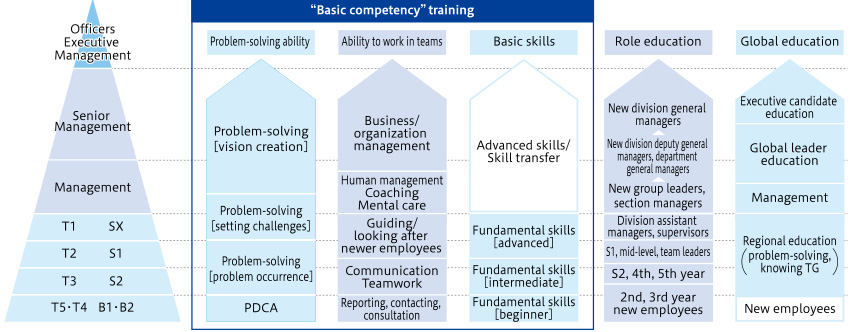
Special Skills Dojos, Maintenance Skills Dojos, and Mold Skills Dojos raise the level of skill on the manufacturing floor
Improving the skills of each worker is an indispensable part of enhancing manufacturing capabilities at production sites. We have therefore introduced various measures with the basic policy of “cultivating a culture that values skills.”
Manager and supervisor training covers more than just the work of managers and supervisors. We have also started a Special Skills Dojo for practical training in each area of manufacturing so that people acquire special skills, and are conducting practical training. For maintenance personnel, we have begun electrical system training to give people the ability deal with increasing robots and IT, and practical training in Maintenance Skills Dojos.
In addition, mold maintenance workers from Toyoda Gosei companies in Japan and other countries as well as affiliated companies participate in Mold Maintenance Dojos to improve their mold maintenance skills. Mold Skills Competitions that test workers’ skills are also held for personnel training in the Toyoda Gosei Group. We have been entering the Skills Olympics since 2017 and in 2019 an employee won the Fighting Spirit Award for punching dies. In 2020 his work area changed to plastic molds, and with the high-level skills and knowledge he gained in his original work he will also be involved in training new employees in the future so that they can play active roles on the production floor.
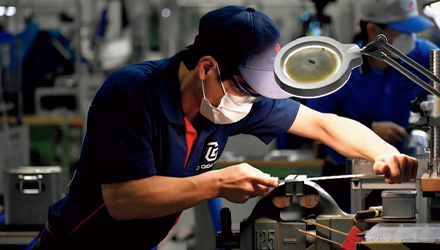
Workplaces that welcome people with disabilities
We view the hiring of persons with disabilities as a social responsibility, and make active efforts in this area. The Committee for Employment of People with Disabilities implements hiring, job assignments, and manager and supervisor education, and helps to establish stable positions. We place particular emphasis on getting people settled in the workplace, monitoring conditions through regular care interviews, taking up problems, and making systematic improvements such as installing accessible restrooms. Work that people with disabilities can perform is identified, and they are systematically hired and placed. As of the end of FY2020 (March 1, 2021), 127 people with disabilities had been hired for a hiring rate of 2.47%, exceeding the legally mandated employment rate of 2.3%.
Our special subsidiary TG Welfare Co., Ltd. holds seminars for people with disabilities for the entire Group and serves in other ways to create places for education and share information with 14 Group companies that have received special affiliate certification, achieving a hiring rate of 2.78% for the Group overall.
■Changes in employment rate for people with disabilities
■Trend in no. of people who tour TG Welfare
Creation of an environment for stable work after retirement
We have established an environment so that employees can work with assurance after retirement in a postretirement rehiring system. Many people can make use of their high levels of expertise and experience after they are rehired. A system of reduced working days and working hours supports working styles for a good worklife balance.
■Trend in cumulative number of re-employed retirees

Support for a full second life
To assist employees who have worked very hard for the company in enjoying a full second life, we provide compulsory training on asset formation to employees from a young age. Age-matched curricula are provided for employees when they join the company and at age 40 and 55 years. Support is given while familiarizing them with and enhancing company systems that help them to systematically form assets in preparation for life events. Spouses may also participate in the training at 55 years old.
Workstyle and workplace culture reforms
From FY2017 we began efforts to make work more efficient with the use of IT, such as enhanced electronic approval and Web conferences, and reviews of meeting structures with the aim of every employee thoroughly executing his or her essential tasks. Overall activities entailing a range of efforts to change the way we work are conducted for workstyle reforms. We are also reviewing personnel systems in order to deal with environmental changes with a sense of speed and raise the quality of work. In conjunction with this, we are eliminating waste and adopting a working style with a varied pace through the creation of opportunities for communication in the workplace, such as informal gatherings with officers and superiors.
■The keys of workstyle reforms
■Example of workplace culture reform activities
■Examples of workstyle and workplace culture reforms
| Perspective | Item | Efforts |
|---|---|---|
| Concentration on essential work | Establishment of a concentration time |
|
| Increased work efficiency | Workstyle (office, technical workers) |
|
| Review of meeting structure |
|
|
| Work kaizen using IT tools |
|
|
| Workplace culture reforms | Management declarations |
|
| Workplace-specific problem resolution |
|
|
| Higher levels of engagement |
|
|
| Workstyle with varied pace | Encouraging people to take annual vacation |
|
- *1 Robotic process automation
Reducing long working hours and raising the annual paid leave taking rate
We are trying to reduce long working hours and encourage people to take their annual paid leave for a better worklife balance.
■Company-wide average overtime hours
■Annual paid leave taking rate
- *2 There were company shutdowns due to COVID-19
(121.8% in cases including holidays)
Creating systems and environments for flexible working styles
■Telework
We have introduced a telework system as one part of our work-style reforms. Changes from the previous workfrom- home system include the introduction of satellite spaces in each business location and increased options in places to work. We are also issuing a Telework Newsletter to share good examples in each department and promote the active use of telework.
■Introduction of hot desking
In parallel with increasing the frequency of telework, we have introduced “hot desking” on some floors in the Headquarters office and Kitajima Technical Center. We will expand this further for a more pleasant work environment. We are making huge reforms in the way work is done, such as paperless work with the use of IT, and implementing a working style that is not bound by place.
■Interviews with new employees on working styles
Labor consultants identify things that are troubling new employees using an interview format, leading to personnel training in the workplace, communication between superiors and subordinates, and improvements in the workplace environment.
| Classification | Targeted persons |
|---|---|
| Office, technical workers | 2nd, 4th, 6th year employees |
| Skilled workers | 2nd year employees, 1st–3rd year female employees |
Engagement survey
Engagement surveys are done for greater improvement in company policies and workplaces by gauging employees’ true feelings through the survey.
From the results of the 2021 survey, it was found that employees work with a sense of responsibility for safety and comply with laws and regulations. It was also found that when important changes in company policy or the way work is done are implemented, the background and reasons for those changes are explained sufficiently to employees. We will continue to make improvements through executive discussions, exchanges of opinions between labor and management, activities in workplace units, and more.
■Schedule of actions for kaizen
Opening of Toyoda Gosei Memorial Gymnasium (ENTRIO)
Entrio was opened in September 2020 with the concept of being a place that would bring people together through sports, make them smile, and energize them. In addition to hosting the official games of company sports clubs and internal company events, it creates excitement and contributes to a sustainable society as a meeting place for people and people, people and companies, and companies and companies.
■Trend in number of men taking childcare leave and leave taking rate
■Major systems for childcare support
■Major systems for care support
Vital and cohesive company culture
Toyoda Gosei Co., Ltd. has held companywide ekiden distance relay races since 2015 with the aim of fostering a sense of unity in the workplace. In 2019 about 1,500 runners, including those from Group companies and business partners, passed the sash while being cheered on loudly by about 1,300 workplace colleagues and family members in cheering squads for each team. The TG Festival (now scheduled to be held at Entrio) and Morimachi Noryo Festival are opportunities to deepen family bonds and ties with the community. We are grateful for the ongoing support, understanding and cooperation we receive, and hold these events with a spirit of hospitality. [Events in FY2020, 2021 were cancelled.]
Sports support
The Wolfdogs Nagoya are regularly in championship contention in Japan’s top volleyball league, and the Blue Falcon won two titles in 2020, their first league championship and the national tournament championship. The Scorpions play in Japan’s B3. League. We aim to foster a sense of unity in employees and the community for a vibrant, rich and active society.
■Main results
| “Wolfdogs Nagoya” volleyball team |
|
|---|---|
| “Blue Falcon” handball team |
|
| “Scorpions” basketball team |
|
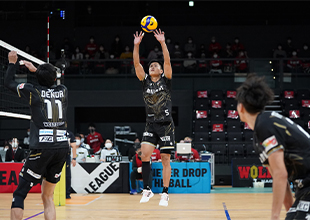 “Wolfdogs Nagoya” Volleyball team
“Wolfdogs Nagoya” Volleyball team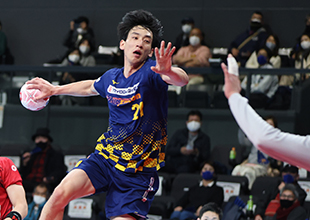 “Blue Falcon” Handball team
“Blue Falcon” Handball team “Scorpions” Basketball team
“Scorpions” Basketball teamSafety and health
Basic policy for safety and health
Toyoda Gosei and the Toyoda Gosei Group consider employee safety and mental and physical health to be one of the most important management issues, and we do our best to ensure secure and pleasant workplace environments for all business activities.
Safety and health efforts
Safety and health declaration
- 1. Compliance with laws and internal regulations and standards related to health.
- 2. With “safety before all” foremost in mind, thorough safety-first behavior by all employees.
- 3. Cultivation of a culture of safety in which activities are conducted with a sense of ownership and there is mutual development with participation by all employees.
Promotion system
To ensure safe and pleasant workplaces, a Central Safety and Health Committee (meets 4 times/year) is organized with the executive in charge of safety as the chairperson. Meetings are attended by the company president, labor union chairperson, plant managers of all locations in Japan, and the presidents of domestic and international affiliates. Various measures related to safety and health are reported and discussed, and the results are spread globally.
In addition to the above, information is sent out repeatedly in the President’s New Year message and company newsletters.
For suppliers, efforts are made to regularly share all relevant information through procurement meetings and other means.
Targets/results
Globally, our target is for zero grave*4 or serious*5 STOP 7*6 accidents. Safety measures for high-risk equipment are promoted at Toyoda Gosei and safety & fire prevention maps (SFPM) are used to visualize the safety and fire prevention level and rectify weaknesses at domestic and international affiliates. As a result, we achieved zero grave or serious STOP 7 accidents globally in FY2020.
| Subject | 2018 | 2019 | 2020 | |
|---|---|---|---|---|
| Number of serious accidents |
Global | 0 | 0 | 0 |
| Number of serious STOP 7 accidents |
Global | 1 | 1 | 0 |
- *4 Grave: death
- *5 Serious: Victim loses part of body (or function)
- *6 STOP 7: Seven things with which there is a possibility of serious injury: (1) being pinched or caught in a machine, (2) heavy objects, (3) falling objects or people, (4) electric shock, (5) vehicles, (6) hot material, explosives, gas, (7) severance
Safety and health management system
Globally, we have introduced and operate labor safety and health management systems centered on risk assessments.
After obtaining JISHA system eligible OSHMS certification, Toyoda Gosei has been voluntarily operating its own system with the addition of internal control items.
| No. of certified businesses |
No. of businesses with in-house operation |
|
|---|---|---|
| Toyoda Gosei Co., Ltd. | ― | 11 companies/ 11 companies |
| Subsidiaries in Japan (JISHA system OSHMS) |
4 companies/ 12 companies |
8 companies/ 12 companies |
| Subsidiaries in other countries (OHSAS 18001) |
12 companies/ 45 companies |
― |
Risk assessments
Risk assessments of equipment are conducted at the time of new installation, modification, and relocation by equipment planning departments, with the purpose of eliminating risk factors in the equipment design and fabrication stages. A safety check is done at the stage before the equipment is used to evaluate compatibility with our own equipment safety criteria to confirm safety.
In manufacturing departments, surveys of workplace risks and hazards are performed and work risk assessments are done to counter them. Reliable implementation of risk reduction measures leads to the prevention of risk.
Safety and health education
Educational curricula are set and various types of education is provided in line with position in the company and timing of needed training. During the coronavirus pandemic a classroom education format was difficult and new trials were started with Web-based education*7 and e-learning.*8
Safety Dojos have also been set up and are being operated at all Toyoda Gosei business locations in Japan to prevent past accidents from fading and to teach employees to sense risks. These dojos are being spread globally.
■Safety and health education by the Safety & Health Promotion Division and number of students (FY2020)
| Name of training/education | Targeted persons | Classroom education | Web-based education | e-learning | No. of students |
|---|---|---|---|---|---|
| Mid-level skilled worker training | Skilled work next-term supervisor candidates | ○ | 42 | ||
| New supervisor training/ TL safety & health education |
Newly promoted/ assigned individuals |
○ | 109 | ||
| Pre-overseas assignment training | Individuals scheduled for overseas subsidiary assignment |
○ | ○ | 33 | |
| Overseas leader, No. 2 pre-assignment training |
Individuals scheduled for overseas subsidiary assignment |
○ | 6 |
- *7 Web-based education: A learning format in which two-way communication is possible on the Web
- *8 e-learning: A self-study format using electronic texts that can be accessed as the individual likes during work intervals
Domestic and international subsidiary audits
With the aim of visualizing the safety and fire prevention level at domestic and international subsidiaries and mitigating weaknesses, safety and fire prevention maps (SFPM) have been established and spread since FY2020. Based on the results of each company’s self-evaluation, attempts have been made to raise the level of safety at 14 domestic subsidiaries with genchi-gembutsu (go and see). Because of the difficulty due to the coronavirus pandemic of directly visiting international subsidiaries for inspections and guidance, this was done with Web-based meetings and guidance using images and videos specialized for four key companies. After reviewing things such as problems in the assessment standards that be came clear through this activity, we will continue using this method in FY2021.
Work accident occurrence
From the safety measures for high-risk equipment that has been continued since 2017, the number of serious STOP 7 accidents has been kept to zero since 2017. However, “pinching” accidents that could lead to grave or serious accidents have continued to occur, and so we have taken measures with priority on elimination of equipment that could pinch or catch workers and lead to grave or serious accidents.
■Safety measures for high-risk equipment and STOP 7 accident occurrence
■Trends in the labor accident rate in the TG Group (rate of lost-worktime injuries)
Health management
Health declaration ̶ To achieve “Boundless Creativity and Social Contribution”
- 1. We believe the health of our employees is an important management issue and will strive to foster an organizational culture that puts safety and health first.
- 2. We will strive to create positive and lively workplaces where employees can work energetically.
- 3. We will support the health of our employees and their families by cooperating with the health insurance association and making efforts for primary prevention*9.
- *9 Activities undertaken with the aim maintaining and improving health and preventing disease, including public health guidance and health education.
Promotion system
With the Safety & Health Promotion Division serving as the executive office, we have established mental and physical health committees consisting of company occupational physicians and members of our Human Resources Division, health insurance union, and labor union. The committees discuss health management measures and track their progress. In addition, activity reports are given and approvals are obtained in our Central Safety and Health Committee, which then spreads these measures to the Safety and Health Committees in each place of business.
Health management
The ability of each employee to work with energy and health into the future is essential as a foundation to fulfill our corporate social responsibility as stated in Toyoda Gosei’s management philosophy. In recognition of this, we are promoting health management to maintain and promote the health of our employees. In 2021 Toyoda Gosei was recognized as an “Outstanding Health Management Corporation” in the large corporation category (White 500).
Turning health awareness and knowledge into action
Health promotion activities in individual workplaces were started in 2016, and in 2020 efforts to improve health with modifications in individual workplaces, such as adopting a theme of exercise, were being made by 206 out of 243 teams.
We have used the “Aichi Health Plus” app, distributed by Aichi Prefecture, since 2020 with the aim of establishing exercise habits. We have also introduced a “Health challenge” in which employees compete in number of steps walked during long holidays. Awards are given to the top people and other efforts are made to further promote exercise.
With these and other activities, Toyoda Gosei was recognized as a “Sports Yell Company 2021” by the Ministry of Education, Culture, Sports, Science and Technology (Japan Sports Agency).
Enhancement of specific health guidance and medical checkups
In 2019 we adopted specific health guidance (active support) for groups in collaboration with the health insurance association. This led to a significant increase in the specific health guidance implementation rate, from 42.6% in 2018 to 98.0% in 2019.
In regular health checkups, we began checking all employees using even tests that occupational physicians say could be omitted, for the early detection of anomalies and to establish healthy lifestyles. Health guidance by occupational physicians and others is given to people in whom any potential problem was found in health checkups.
Dietary improvements
In employee cafeterias, the amounts for total calories, fat, salt, and carbohydrates are displayed on each food item. Moreover, we are building a system that can check calories consumed in monthly units for employees to use in self-control. In 2019 we also started providing “smart meals” in cooperation with food service providers.
Efforts to maintain and improve women’s health
In 2018, we introduced a “Breast self-check seminar” using a palpation model. In 2020, we distributed breast check gloves to all women in collaboration with the health insurance association, and are encouraging them to perform breast self-examinations.
With the aim of raising the rates of breast cancer and uterine cancer examinations, we send individual letters to women 20, 30, and 35 years old calling on them to undergo cancer screening.
In 2020, we conducted our first awareness survey of health literacy for female employees. The results indicated that even when individuals obtained information many lacked the confidence to select the most beneficial information and incorporate it into their actual lives. Therefore, we provided advice on how to gather health information that can be used in actual life.
The survey also revealed that women in their 30s and 40s were sometimes unable to recover from fatigue with sleep. We prepared and began distributing a self-care pamphlet for female employees who are returning to work after maternity leave, a period when they were starting to balance work and child care.
Anti-smoking measures
With the aim of preventing health damage in smokers and passive smoking in non-smokers, we first banned the sales of cigarettes in the company (including vending machines). At the same time, we provided support by public health nurses to help smokers quit smoking. Since 2016 we have held “Smoking cessation talks” with invited outside instructors and held experience-based exhibitions that include measurements of lung age as motivation to quit smoking.
In anticipation of the Revised Health Promotion Act in Japan, which went into full effect in April 2020, we extended a smoking ban on all company property in the country starting in January 2020. At that time, the ban on employee smoking was not limited to company property but was extended to at least 100m from the property boundaries to prevent passive smoking by neighborhood residents. In cases when a nursery school or medical institution was in that zone, we expanded the ban zone to include the area around them.
To protect all people working in the company from passive smoking, we set a company policy with the aim of preventing harmful passive smoking. In addition to steady efforts beforehand to gain employees’ understanding, we made repeated requests to staffing agencies and contractors for their cooperation. Today, one year after the smoking ban on company property, its continuation has had no effect on productivity or employee retention.
The company-wide smoking rate has decreased from 42.5% in 2010 to 27.5% in 2020.
■Smoking rate at Toyoda Gosei
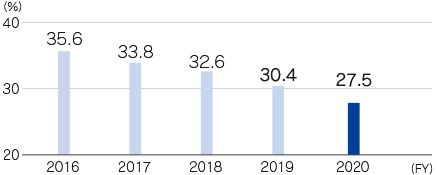
Responding to and preventing mental health problems
A Mental Health Committee was established by the Human Resources Division, health insurance association, labor union, and Safety & Health Promotion Division. Individual consultations by public health and other nurses and an employee assistance program (EAP)*10 (Ministry of Health, Labor and Welfare) have been introduced, and education for managers and supervisors is provided. Since FY2020 we have focused on sleep, since sleeping problems can be an early sign of mental health problems. Wearable devices are used to try to “visualize” the quality of sleep, and we are making efforts to prevent the recurrence of mental health problems by catching signs early.
Acquiring stress coping methods through e-learning and other means can lead to prevention of problems in people when they are susceptible, such as when they have just been promoted, are hired mid-career, or have been transferred to a new workplace.
As a result of these efforts, the number of people taking leave for mental health problems decreased 24% in FY2019 compared with the previous year, and another 11% in FY2020 compared with FY2019.
- *10 Employee assistance program in which outside specialists support the mental health of employees
Prevention of infections among employees
Subsidies for antibody tests for diseases such as measles and rubella were added to the company benefit system in 2020. Partial subsidies are also given for influenza vaccinations, including for family members.
In response to the novel coronavirus we have prepared infection prevention guidelines, update them as needed, and are spreading them globally to prevent infections. In addition, to counter diseases such as AIDS (including HIV infection), tuberculosis, and malaria that are subject to notification based on the Infectious Diseases Act, our Crisis Management Guide details prevention and initial response methods and we are familiarizing employees with them.
Many types of health education
We previously provided level-specific mental health education for managers and supervisors with follow-up education every three years, but this was cancelled in 2020 in order to prevent the spread of COVID-19. We plan to restart this education using the Web in FY2021. Other age-specific health education also had to be cancelled in FY2020, but we plan to start new health education in FY2021 while avoiding the “3Cs” (closed spaces, crowded spaces, close-contact settings) with measures such as smaller groups, and by effectively using the Web.
Spreading health management to subsidiaries in Japan
In 2018, we established TG Group Mental Health Activity Meetings and have promoted mental health activities at all subsidiaries. As a result, we have been able to carry out efforts including mental health education, contracts with psychiatrists, and the introduction of EAPs in each company.
From 2021 we have changed the name to Health Promotion Meetings and have transitioned to activities that cover overall health, including physical health.*11 Specific areas include (1) Planning targets for smoking bans on company grounds and support to achieve those targets, (2) information sharing and promotion of health creation activities, and (3) information sharing and promotion of mental health activities.
As a result of these efforts, two subsidiaries were certified as Outstanding Health Management Corporations (medium and small business category).
In addition, 10 of 13 companies had banned smoking at business locations by March 2021, and the remaining three are planning to start smoking bans on their grounds by March 2022.
- *11 Aspects of physical health including various types of health checkup, prevention of lifestyle-related disease, anti-smoking measures, and various types of health promotion

